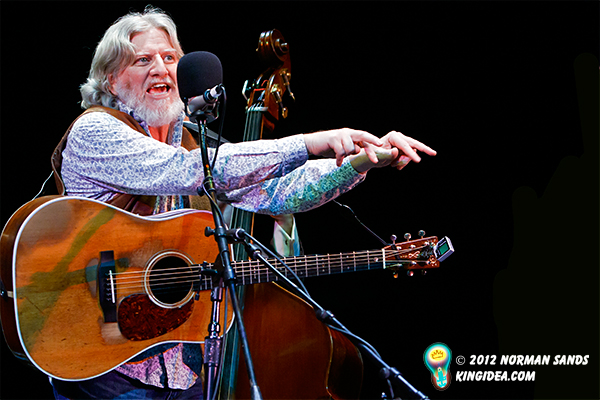
Photo by Norman Sands
Now in its fourth year, the Chicago Bluegrass and Blues Festival is an event that keeps expanding, like a gaseous nebulae in the vacuum of space. The event kicked off with a three night run of the String Cheese Incident at the Aragon Ballroom in Chicago’s Uptown neighbourhood last month. Six weeks later, the event picked up again with a bluegrass lineup so fine it would put most of Bean Blossom’s festivals to shame.
The first act on the main stage, Majors Junction, an up-tempo Americana outfit, had difficulty getting into their groove playing to a large room that was still filling in. There are some threads of Johnny Cash coming through in their style. There’s some close family ties in this band; guitarist Mike Mulcahy, his wife Heather O’brien and her sister Kiley O’Brien do the singing on songs that are mostly written by Mike.
Chicago’s finest traditional bluegrass players, The Henhouse Prowlers, brought the energy level in the room up quite a bit. Playing with two brand new members, Dan Andree (fiddle) and Star Moss (guitar), didn’t keep this band from cruising through a set full of originals and bluegrass staples. They even played a couple new songs written with their new members. The pre-existing three members, Jon Goldfine (bass), Ben Wright (banjo) and Grant Ziolkowski (mandolin) handled a majority of the singing, with Andree taking the lead for a composition of his own. The diversity in their vocal timbre gives them a broad versatility.
The Giving Tree Band’s equipment crowded every corner of the ample sized stage. On stage right was a Hammond B-3 organ, complete with a Leslie speaker cabinet, and stage left had a black upright piano. Eric Fink, the enigmatic leader of the band, spent most of the set center stage, next to his brother Todd Fink on banjo. At one point, the Fink brothers fetched a matching banjo and telecaster. The solid top banjo, complete with Fender-esque cutaway and tortoise shell pickguard, had a very unique, bright sound for the bluegrass instrument. There is a remarkable level of balance between the seven performers that comprise The Giving Tree Band, resulting in a layered texture in which you can listen to any member’s playing at any time.
Joe Purdy is a talented solo folk performer in his own right, but he must have felt lonely up on that big stage all by himself. He invited The Giving Tree Band to join him for most of his set. Patrick Burke traded in his electric bass for an upright while Eric Fink found his way to the B-3. Purdy seems to channel a younger Dylan when he’s singing full throttle. The harmonica held around his neck adds to a classic folk singer appearance.
Following Purdy with the Giving Tree reprise, the Auditorium Theater was treated to some Dawg music. The David Grisman Quintet’s purely instrumental approach results in a performance at the highest level of musicianship. Grisman himself is a great story teller; he leads into each song with a story that connects the audience to the music. He has a magical way of introducing his co-conspirators. Take for example Garcia Grisman Band member and 27 year DGQ veteran James Kerwin, who scurried off stage so that he could gingerly approach his bass from behind the curtains as the crowd cheered him on.
The DGQ has superb chemistry that has developed over the last few decades. Anytime one of the players is taking a solo, the supporting cast pulls back so break can rise above in the mix without sacrificing dynamic control. Grisman leads into “Slinky” stating “I think it’s time to get funky;” turn to Matt Eakle who wields a bass flute marvellously. Eakle and guitarist Grant Gordy play parallel leads on the outro from this tune. Grisman then introduces guest mandolinist Don Stiernberg to finish the last few songs of the set with DGQ. They really bring it home with a “Shady Grove” that the crowd ate up.


No Comments comments associated with this post